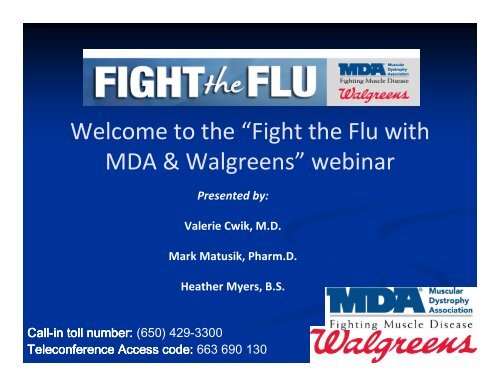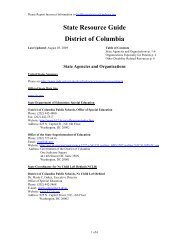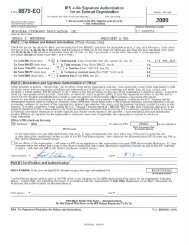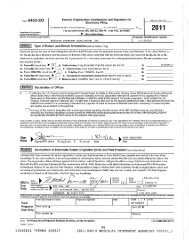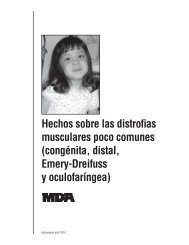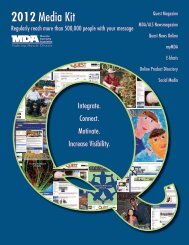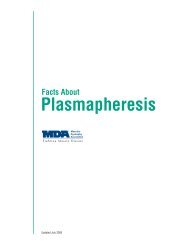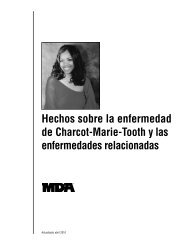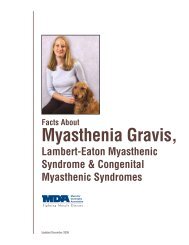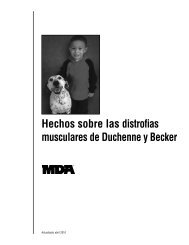Fight the Flu with MDA & Walgreens - Muscular Dystrophy Association
Fight the Flu with MDA & Walgreens - Muscular Dystrophy Association
Fight the Flu with MDA & Walgreens - Muscular Dystrophy Association
- No tags were found...
You also want an ePaper? Increase the reach of your titles
YUMPU automatically turns print PDFs into web optimized ePapers that Google loves.
Welcome to <strong>the</strong> “<strong>Fight</strong> <strong>the</strong> <strong>Flu</strong> <strong>with</strong><strong>MDA</strong> & <strong>Walgreens</strong>” webinarPresented by:Valerie Cwik, M.D.Mark Matusik, Pharm.D.Hea<strong>the</strong>r Myers, B.S.Call-in toll number: (650) 429-3300Teleconference Access code: 663 690 130
Valerie A. Cwik, M.D.Dr. Valerie Cwik, Executive Vice President — Research and MedicalDirector for <strong>the</strong> <strong>Muscular</strong> <strong>Dystrophy</strong> <strong>Association</strong> (<strong>MDA</strong>), oversees<strong>MDA</strong>'s extensive research and health care services programs andrepresents <strong>the</strong> <strong>Association</strong> at national and international scientificmeetings. Dr. Cwik has focused her career on neuromusculardiseases, beginning <strong>with</strong> fellowship training in EMG andneuromuscular diseases at <strong>the</strong> Cleveland Clinic from 1989 to 1990under <strong>the</strong> mentorships of Dr. Asa Wilbourn and Dr. HiroshiMitsumoto. A second fellowship in neuromuscular diseases at <strong>the</strong>University of Alberta, under <strong>the</strong> mentorship of Dr. Michael Brooke,was followed by her appointment as assistant professor of medicine(neurology) at <strong>the</strong> same institution.In 1996, Dr. Cwik relocated to Tucson, Ariz., where she directed <strong>the</strong>Neuromuscular Disease Program in <strong>the</strong> Department of Neurology atThe University of Arizona from 1996 through early 2004; she wasdirector of <strong>the</strong> <strong>MDA</strong>/ALS Center <strong>the</strong>re from 2001 through 2004. Dr.Cwik has experience in clinical trials for Duchenne musculardystrophy, ALS and diabetic peripheral neuropathy, and hasmentored several neuromuscular fellows.
Mark Matusik, Pharm.D.Dr. Mark Matusik is a residency-trained managedcare pharmacist who has worked for <strong>Walgreens</strong> formore than 15 years. He is responsible for <strong>the</strong> salesoperations and contracting of <strong>the</strong> immunizationprogram across <strong>the</strong> United States for <strong>the</strong><strong>Walgreens</strong> Company. He also is one of over 26,000certified immunizers at <strong>Walgreens</strong>.Dr. Matusik graduated from Midwestern University<strong>with</strong> a B.S. in pharmacy in 1995 and a Doctor ofPharmacy degree in 1996. After graduation, hecompleted a one year residency program inManaged Care Pharmacy. Dr. Matusik also is anadjunct assistant professor at MidwesternUniversity, teaching <strong>the</strong> Intro to Managed CarePharmacy class to third-year pharmacy students,and is a guest lecturer at both MidwesternUniversity and <strong>the</strong> University of Illinois at Chicagopharmacy schools.
Hea<strong>the</strong>r Myers, B.S.Hea<strong>the</strong>r Myers is <strong>the</strong> Associate Director ofHealth Care Services for <strong>MDA</strong>. In this position,Hea<strong>the</strong>r coordinates <strong>MDA</strong>'s <strong>Flu</strong> Shot Programand assists in <strong>the</strong> oversight of <strong>MDA</strong>'snationwide clinical program.A Tucson native, Hea<strong>the</strong>r graduated from <strong>the</strong>University of Arizona <strong>with</strong> a B.S. in businessand took advantage of an opportunity tovolunteer <strong>with</strong> <strong>MDA</strong>, assisting <strong>with</strong> localTelethon duties. In 2004, Hea<strong>the</strong>r began heremployment at <strong>MDA</strong>'s National Headquarters,working as an administrative assistant to <strong>the</strong>director of field organization. Within months,she accepted an offer to join <strong>the</strong> Health CareServices department, where she receivedseveral promotions leading up to her currentposition.
<strong>Flu</strong> Shot Program <strong>MDA</strong> covers <strong>the</strong> cost of seasonal flu shots forindividuals registered. <strong>MDA</strong> and <strong>Walgreens</strong> expanded this year’spartnership to make discount couponsavailable to family members and in-homecaregivers.
Easy as… 1, 2, 3! Step 1: Visit <strong>MDA</strong>’s <strong>Flu</strong> Season ResourceCenter to fill out request form Step 2:Check your mailbox! Show up to any of over 8,000 <strong>Walgreens</strong> andDuane Reade pharmacies, including morethan 350 Take Care Clinics at select <strong>Walgreens</strong>
<strong>Walgreens</strong> & <strong>MDA</strong> <strong>Walgreens</strong> has been partnering <strong>with</strong> <strong>MDA</strong> for4 years, providing flu shot services to <strong>the</strong>irmembers across <strong>the</strong> United States <strong>Walgreens</strong> supports <strong>MDA</strong> through: Customer donations – Shamrock sales Summer Camp support Event sponsorship Telethon participation
What is in <strong>the</strong> “<strong>Flu</strong> Shot”? World Health Organization (WHO) Each year <strong>the</strong> WHO predicts which strain of flu will mostlikely be <strong>the</strong> most prominent strains in both <strong>the</strong> Nor<strong>the</strong>rnand Sou<strong>the</strong>rn hemispheres. For <strong>the</strong> 2011-12 nor<strong>the</strong>rn hemisphere influenza season<strong>the</strong> following were recommended and are covered <strong>with</strong>inthis year’s season flu vaccine: an A/California/7/2009 (H1N1)-like virus an A/Perth/16/2009 (H3N2)-like virus a B/Brisbane/60/2008-like virus Trivalent vaccine = 3 strains covered
What types of vaccine are available? Inactivated or “killed” vaccine Standard Injectable Multi-dose vial = delivered to majority of <strong>the</strong> population Preservative-free = single-dose syringe Indicated for anyone 6 months of age or older High-Dose Contains 4x <strong>the</strong> antigen Indicated for elderly and o<strong>the</strong>rs <strong>with</strong> reduced immune response Intradermal (i.e. delivered in <strong>the</strong> skin) New in 2011Note: Not offered at <strong>Walgreens</strong> at this time
What types of vaccine are available?Live attenuated influenza vaccine (LAIV) contains live but attenuated(weakened) influenza virusIntranasal (please note: this form not available through <strong>MDA</strong>)Indicated for individuals 2-49 years oldNot indicated for pregnant women or people who have long-term healthproblems such as: heart disease kidney or liver disease lung disease metabolic disease, such as diabetes asthma anemia, and o<strong>the</strong>r blood disorders Anyone <strong>with</strong> certain muscle or nerve disorders (such as seizure disorders orcerebral palsy) that can lead to breathing or swallowing problems.
How do I get a flu shot at <strong>the</strong><strong>Walgreens</strong> pharmacy orTake Care Clinic?
How do I get a flu shot at <strong>the</strong><strong>Walgreens</strong> pharmacy orTake Care Clinic?Request a voucher from www.mda.org (Live demo to follow)Bring voucher into any <strong>Walgreens</strong> pharmacy or Take Care Clinic Present voucher to Technician/clinic staff Fill out Vaccination Administration Record (VAR) Receive your flu shotRecords may be obtained anytime ei<strong>the</strong>r online or in-store
Can I get my children immunized? State laws vary <strong>with</strong> regard to pharmacist’s immunization privilege All <strong>Walgreens</strong> stores can immunize anyone 18+ years old Based on state law, some <strong>Walgreens</strong> pharmacists may provideimmunizations to children as young as 7 years old. Children 7-8 years old may require additional doseAge <strong>Flu</strong> Vaccination History Recommended DosingNo historyOne dose inj. followed by a seconddose of inj. 28 days after 1st dose7-8 OR ORReceived 2 doses in <strong>the</strong> past but no historyof receipt of at least 1 dose of influenza A(H1N1) 2009 monovalent vaccineOne dose of <strong>Flu</strong>Mist in each nostrilfollowed by a second dose 28 daysafter 1st dose
Can I get my children immunized?Age <strong>Flu</strong> Vaccination History Recommended Dosing1 dose (during 1st year of vaccination)One dose inj. followed by a second doseof inj. 28 days after 1st dose7-8 OR OR1 dose (during previous season)One dose of <strong>Flu</strong>Mist in each nostrilfollowed by a second dose 28 days after1st doseOne dose of inj.7-8 2 doses OR(1 dose received during previous twoseasons)9 andAboveAny historyOne dose of <strong>Flu</strong>Mist in each nostrilOne dose of inj. Take Care Clinics may immunize children as young as 2 years old. Call ahead to ask your healthcare professional at <strong>the</strong> store/clinic as<strong>the</strong>y will know <strong>the</strong>ir state-specific limitations.OROne dose of <strong>Flu</strong>Mist in each nostril15
What is <strong>the</strong> flu? A contagious viral illness Infects <strong>the</strong> nose, throat and lungs A number of different viruses can cause <strong>the</strong>flu Symptoms may be mild to severe <strong>Flu</strong> may be life-threatening for some
What does it feel like to have <strong>the</strong> flu? Fever and chills Cough Sore throat Runny or stuffed up nose Muscle aches Headache Fatigue Vomiting and diarrhea – especially in children
How do you catch <strong>the</strong> flu? Usually spread through droplets fromcoughing, sneezing or even talking Droplets can land in <strong>the</strong> nose or mouth ofpeople who are nearby Viruses can live on hard surfaces for someperiod of time – doorknobs, utensils, cups orglasses, telephones, etc. <strong>Flu</strong> can be spread by touching those surfaces,<strong>the</strong>n touching <strong>the</strong> mouth, eyes or nose
When is someone <strong>with</strong> <strong>the</strong> flucontagious? Before and while you are sick! Up to 1 day before symptoms develop Up to 5 – 7 days after becoming sick
Is <strong>the</strong> flu serious? How serious <strong>the</strong> flu is depends on manyfactors: The flu viruses that are circulating How much and when flu vaccine is available How many people get vaccinated How effective <strong>the</strong> flu vaccine is for <strong>the</strong> virusesthat are causing <strong>the</strong> flu that year
Why be concerned about <strong>the</strong> flu? <strong>Flu</strong> can be a very serious illness, especially for: Older people Young children Pregnant women People <strong>with</strong> chronic health conditions Persons who live in nursing homes People <strong>with</strong> weakened immune systems, including thoseon chronic steroids or o<strong>the</strong>r immune suppressingmedications
Should I be more concerned about <strong>the</strong> fluif I have a neuromuscular disease? Everyone should be concerned about <strong>the</strong> flu. People <strong>with</strong> neuromuscular diseases,especially if <strong>the</strong>y have weakness of <strong>the</strong>muscles that control breathing, are atincreased risk for complications of <strong>the</strong> flu.
What are <strong>the</strong> complicationsof <strong>the</strong> flu? Dehydration Bacterial pneumonia Ear infections Sinus infections Worsening of chronic medical conditions Immobilization
How to prevent <strong>the</strong> flu Get vaccinated each year All individuals in <strong>the</strong> household should bevaccinated The earlier you get vaccinated, <strong>the</strong> better
What else can you do toprevent <strong>the</strong> flu?Educate family members and visitors about <strong>the</strong> heightened risk ofrespiratory infections for people <strong>with</strong> neuromuscular disease.Promote good and frequent hand hygiene. Wash hands <strong>with</strong> soap andwater for at least 20 seconds, especially after coughing or sneezing.Alcohol-based hand sanitizers containing at least 60 percent alcohol alsoare effective.Encourage respiratory etiquette — cover coughs and sneezes <strong>with</strong> a tissueor an arm.Stress <strong>the</strong> importance of not sharing utensils and drinking cups, and of nottouching eyes, nose or mouth, especially after handling shared items suchas telephones or remote controls.Visit <strong>the</strong> Centers for Disease Control and Prevention (cdc.gov) and <strong>Flu</strong>.govfor additional tips and recommendations.
What should you do if youthink you have <strong>the</strong> flu?Contact your doctorYour doctor will decide if you need to be seen in his/her officeHe/she may want to treat you <strong>with</strong> anti-viral medications, which canshorten <strong>the</strong> course and/or reduce <strong>the</strong> intensity of <strong>the</strong> fluDrink plenty of fluids – try not to get dehydratedAlso, you may not feel hungry, but try to keep up yournutritionGood respiratory toiletry is important – coughing up phlegmor secretions so <strong>the</strong>y don’t move into your lungs. If you have aweak cough, you should contact your pulmonologist orrespiratory <strong>the</strong>rapist – <strong>the</strong>re are ways to try to keep <strong>the</strong>airways clear, such as cough-assist devices.
Live Tour:<strong>MDA</strong>’s <strong>Flu</strong> Season Resource Center
Questions?
Thank You!Today’s webinar will be archived andavailable for viewing on <strong>MDA</strong>’s website atwww.mda.org/services/webinarFor additional questions,contact <strong>the</strong> <strong>MDA</strong> Health Care Services Dept.at (800) 572.1717 orhealthcareservices@mdausa.org


